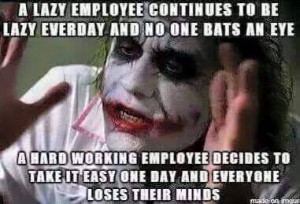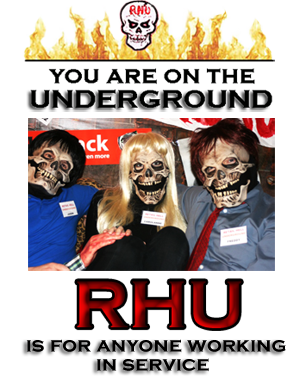
Employees can now share their opinions about employers online. As a result, companies face new reputation risks that can affect their customers and shareholders.
For the third year, 24/7 Wall St. has identified the nation’s worst companies to work for. 24/7 Wall St. analyzed thousands of reviews from jobs and career website Glassdoor.com and selected the 11 companies with the lowest ratings.
Many of the companies on this list continue to be in the retail sector. As a result, complaints tended to focus on wages and hours worked. In many cases, these concerns focused on how difficult it can be for sales employees to meet targets that qualified them for commissions.
In other instances, employees complained more about how they thought a company was mishandling its customers. In the case of the Children’s Place, employees protested the pushy sales tactics. Jos. A. Bank employees wrote that the company’s changing product prices made it hard for them to make sales.
However, employees working in retail are not all unhappy. Scott Dobroski, associate director for corporate communication at Glassdoor.com, suggested that pay plays a big part. “We know that compensation is the number one factor job seekers consider when determining where to work.” Starbucks and Costco are examples of retail companies that offer benefits or pay above the industry average and that employees rate highly.
A significant share of employee grievances was directed at middle management. Workers at these companies were also highly likely to disapprove of their CEO. Chief executives at 10 of the 11 worst companies to work for received positive approval ratings from less than half of their employees. At six of these businesses, less than 30% of workers endorsed the CEO.
In the case of a number of these businesses, such as RadioShack and hhgregg, falling revenues, weak earnings and a sinking stock price may all contribute to lower employee morale and negative perceptions of executive performance.
However, negative employee opinions are not always a direct reflection of a company performance. Dillard’s has been a Wall Street darling. The company’s stock price has risen tenfold in the past five years.
To identify America’s worst companies to work for, 24/7 Wall St. independently examined employee reviews on Glassdoor.com. To be considered, companies had to have a minimum of 300 reviews. Of the more than 500 companies with more than 300 reviews, 24/7 Wall St. identified the 11 publicly traded companies that received the worst scores — 2.4 or lower. Employee totals are from each company’s latest 10-K filing.
These are America’s worst companies to work for
11. RadioShack
> Rating: 2.4
> Number of reviews: 1,255
> CEO approval rating: 46% (Joseph C. Magnacca)
> Employees: 27,500
> Industry: Electronics retail
RadioShack Corp.’s (NYSE: RSH) abysmal performance in recent years has reflected poorly on senior management. Employees rated senior management 2.2 out of a possible 5.0. And less than half of employees approve of CEO Joseph Magnacca. Many reviews cited low wages and poor benefits, conditions that often lead to employee dissatisfaction. While entry-level retail associates complained of inadequate hours, the opposite was true for store managers. One reviewer said that, considering the long hours managers put in, the increased salary isn’t really much higher.
After $400 million loss last year — the second consecutive year in which the company has lost money — RadioShack said it could close more than 1,000 of its retail outlets this year, roughly a quarter of its U.S. company-operated stores. Despite RadioShack’s efforts to remain competitive in the ever-evolving electronics industry, the retailer is nearing irrelevancy. According to The Wall Street Journal, 25% of all electronics purchases were made online in 2013.
10. Children’s Place
> Rating: 2.4
> Number of reviews: 427
> CEO approval rating: 27% (Jane Elfers)
> Employees: 16,500
> Industry: Apparel retail
Generous employee benefits — such as up to 30% off including clearance items — contributed to numerous positive reviews for The Children’s Place Inc. (NASDAQ: PLCE). Such perks, however, did little to offset complaints regarding low pay and difficulties in getting adequate hours. Entry-level sales associates disapproved of training protocols by and large. These protocols include promoting rewards programs and other pushy sales practices when dealing with customers. Like with many of the companies on this list, the company’s CEO is unpopular. According to Glassdoor.com reviews, just over one in four employees approve of the way CEO Jane Elfers is running the company, among the lower approval ratings on Glassdoor.com.
Shareholders, too, are likely unhappy with the company. Revenues have been relatively flat in recent years, while earnings per share have declined in each of the past four years. Over the past year, the company’s share price has dropped by about 4.5%, even as the stock market has largely risen.
9. Family Dollar Stores
> Rating: 2.4
> Number of reviews: 509
> CEO approval rating: 39% (Howard R. Levine)
> Employees: 58,000
> Industry: Discount retail
Like many retail operations, Family Dollar Stores Inc. (NYSE: FDO) offers entry-level workers low-paying high-stress employment. Family Dollar has added hundreds of stores in the past several years, reaching a total of 8,100 U.S. retail outlets. According to numerous employee reviews, however, these new stores are the most likely to be poorly run. One such reviewer complained about inconsistent schedules, part-time hours, product shortages and overall chaotic management.
Family Dollar’s CEO received a 39% approval rating, hardly spectacular but better than a number of peers running companies with the lowest employee reviews. However, the opinion that matters most may be that of famed activist investor Carl Icahn, who recently disclosed a sizable stake in the discount retailer. Icahn has announced that he will push for Family Dollar to sell itself via an acquisition or shareholder buyout.
8. hhgregg
> Rating: 2.4
> Number of reviews: 397
> CEO approval rating: 36% (Dennis L. May)
> Employees: 6,100
> Industry: Electronics retail
hhgregg Inc. (NYSE: HGG) is a 58-year old electronics and home furniture retailer with 6,100 total employees and 228 stores as of March. Employees largely had negative views of the company, often criticizing its commission-based compensation model. Former and current sales staff also indicated that the commission structure, which rewarded employees for selling highly profitable items, often felt arbitrary or unfair. One employee noted that, “they make you do a lot of operational work and since you are on commission you don’t get paid for that work.”
hhgregg has failed to impress shareholders as well. The company has struggled with declining sales and earnings of in recent years. Its shares fell more than 40% in the past year alone, even as the broader stock market has risen substantially in that time.
7. ADT
> Rating: 2.4
> Number of reviews: 561
> CEO approval rating: 48% (Naren Gursahaney)
> Employees: 17,000
> Industry: Security and alarm services
Home and business security systems company ADT Corp. (NYSE: ADT) is the largest company of its kind in North America. It currently serves more than 6 million customers, but its popularity does not mean employees are satisfied. Sales representatives, who pitch the company’s security package door-to-door or over the phone, were among the most likely to give the company a poor review. Employees complained of stressful commission-based pay structures.
In addition to criticisms from employees, ADT has also been scrutinized by regulators. The company has come under criticism for secretly paying experts to endorse its systems on TV shows and in interviews. ADT has recently reached a settlement with the Federal Trade Commission on the matter.
6. Dillard’s
> Rating: 2.3
> Number of reviews: 913
> CEO approval rating: 24% (Bill Dillard II)
> Employees: 40,000
> Industry: Department stores
Founded in 1938, Dillard’s Inc. (NYSE: DDS) is currently among the largest clothing and home furnishings retailers in the nation. The company owned and operated nearly 300 stores nationwide as of the beginning of this year, and employed roughly 40,000 workers, just less than half of which were part-time workers. Like many other entry-level retail positions, sales jobs at Dillard’s tend to involve penalties for unmet sales goals. While these pay structures offer higher wages for high achievers, employees reported poor job security and unreliable work schedules.
While employees appear unhappy, customers are relatively satisfied with Dillard’s. Americans are more satisfied with Dillard’s than with most department stores. Customer satisfaction, as measured by its American Customer Satisfaction Index (ACSI) score, rose 2.5% last year. Investors, too, are likely happy with Dillard’s. Shares have risen by more than 1,100% in the past five years.
5. Brookdale Senior Living
> Rating: 2.3
> Number of reviews: 322
> CEO approval rating: 51% (T. Andrew Smith)
> Employees: 49,000
> Industry: Senior living facilities
Brookdale Senior Living Inc. (NYSE: BKD) is an operator of assisted-living communities. Employees of the company are among the most miserable. Numerous current and former employees reported poor management, understaffing and high turnover. A large proportion of the company’s nearly 49,000 employees are considered part-time. Yet, several reviews cited hours well in excess of traditional part-time schedules. Some employees have expressed concern over the company’s increased focus on profits. “They’ve lost sight of their values — the bottom line comes first and the residents are last,” one reviewer said on Glassdoor.com. Despite these complaints, however, CEO Andrew Smith had a better approval rating than his counterparts at any of the other companies on this list, at 51%.
Brookdale recently announced it would merge with Emeritus Corporation, another senior living company. The companies said that after the merger, 6.5 million Americans 80 years of age and older will live in relative proximity to one of the two companies’ facilities.
4. Jos. A. Bank Clothiers
> Rating: 2.3
> Number of reviews: 317
> CEO approval rating: 24% (R. Neal Black)
> Employees: 6,469
> Industry: Apparel retail
Sales managers at Jos. A. Bank Clothiers Inc. (NASDAQ: JOSB) frequently expressed frustration at the number of hours they were required to work. Sales workers often complained as well, with many citing a difficult commission structure and the company’s ever-changing product prices. While many employees said they enjoyed helping customers immensely, others felt customers were often demanding.
But while employees were unhappy with the company, Jos. A. Bank’s former shareholders had reason to be quite pleased. After months of bitter back-and-forth negotiations — which helped to drive up Jos. A. Bank’s share price — the clothing retailer was acquired by Men’s Wearhouse for $1.8 billion in March. The deal formally closed in mid-June. Unlike Jos. A. Bank employees, Men’s Warehouse’s staff has a higher view of their business, with employees awarding their company a 3.3 rating on Glassdoor.com.
3. Frontier Communications
> Rating: 2.3
> Number of reviews: 306
> CEO approval rating: 27% (Maggie Wilderotter)
> Employees: 13,650
> Industry: Telecom services
Frontier Communications Corp. (NASDAQ: FTR) is one of the larger communications companies in the United States, known primarily for providing services to rural and smaller American towns and cities. While Frontier Communications has been downsizing its workforce in recent years –headcount dropped by roughly 1,000 between 2012 and 2013 — the company considers its relationship with its employees to be good. Its employees may disagree, however. A number of reviewers seem to think Frontier Communications is no longer on the forefront of communications technology. One current employee explained, “The reason you can’t hire is that no one wants to work on a dinosaur.”
Despite the challenges of providing services to small, remote populations, Frontier has sought to expand its control of the rural market in recent years. The company bought 4.8 million access lines from Verizon in 2009. The company’s revenue, however, declined from $5.2 billion in 2011 to $5.0 billion in 2012 and then to $4.8 billion last year.
2. Express Scripts
> Rating: 2.2
> Number of reviews: 646
> CEO approval rating: 28% (George Paz)
> Employees: 29,975
> Industry: Health care services
Express Scripts Holding Co. (NASDAQ: ESRX) is a leading pharmacy benefits manager, facilitating a wide range of pharmaceutical drug operations, including distribution and cost management. Poor work-life balance was one of the most common complaints among Glassdoor.com reviews. One former employee wrote, “work life balance is nonexistent, you are expected to be available to work all the time.” Less than a third of employees approved of Express Scripts’ CEO George Paz.
Unlike several other companies on this list, Express Scripts has grown considerably in recent years. After a merger with Medco Health Solutions in 2012, Some employees expected the company to conduct layoffs. Total employment declined only slightly, however.
1. Books-A-Million
> Rating: 2.0
> Number of reviews: 302
> CEO approval rating: 22% (Terry Finley)
> Employees: 5,400
> Industry: Specialty stores
Books-A-Million Inc. (NASDAQ: BAMM) employed roughly 5,400 workers at more than 250 U.S. stores as of the beginning of this year, most of which were part-time. Like many retailers with unhappy employees, Books-A-Million institutes commission-based pay structures. Perhaps as a result, high stress and low pay were common complaints on Glassdoor.com. One employee wrote, “to[o] much stress for the pay, very low pay, low chance of promotion, hours are based on magazine and discount card sales. Even if you’re normally good, if you have a bad week you get cut.”
Just 14% of employees said they would recommend this company to a friend. Books-A-Million’s culture and value were rated just 1.8, the lowest among companies reviewed. CEO Terry Finley is also not popular, with just 22% thinking he is doing a good job. Over the past several years, the company has struggled to keep up with other large retail and online book sellers like Barnes & Noble and Amazon.com
Sourced from: America’s Worst Companies to Work For

































Recent Comments